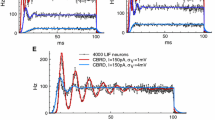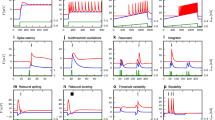Abstract
A firing rate (FR) model for a population of adaptive leaky integrate-and-fire neurons has been proposed. Unlike known FR models, it describes more precisely the unsteady firing regimes and takes into account the effect of slow potassium currents of spike adaptation. Approximations of the adaptive channel conductances are rewritten from voltage-dependent to spike-dependent and then to rate-dependent ones. The proposed FR model is compared with a very detailed population model, namely, the conductance-based Refractory Density model. This comparison shows the coincidence of the first peak of activity after the start of stimulation as well as of the stationary state. As an example of simulation of coupled adaptive neuronal populations, a ring model has been constructed, which reproduces a visual illusion known as tilt after-effect. The FR model is recommended for mathematical analysis of neuronal population activity as well as for computationally expensive large-scale network simulations.
Similar content being viewed by others
Abbreviations
- (A)LIF:
-
(adaptive) leaky integrate-and-fire
- HH:
-
Hodgkin-Huxley
- FR:
-
firing-rate
- RD:
-
refractory density (model)
References
P. Dayan and L. F. Abbott, Theoretical Neuroscience (MIT Press, Cambridge, Mass., 2002).
M. N. Zhadin, Biofizika 39(1), 129 (1994).
O. Shriki, D. Hansel, and H. Sompolinsky, Neural Comp. 15, 1809 (2003).
B. W. Knight, J. Gen. Physiol. 59, 734 (1972).
A. Omurtag, B. W. Knight, and L. Sirovich, J. Comput. Neurosci. 8, 51 (2000).
J. Eggert and J. L. van Hemmen, Neural Comp. 13, 1923 (2001).
D. Nykamp and D. Tranchina, J. Comput. Neurosci. 8, 19 (2000).
W. Gerstner and W. M. Kistler, Spiking Neuron M odels:Single Neurons, Populations, Plasticity (Cambridge University Press, Cambridge, 2002).
V. L. Dunin-Barkovskii, Informational Processes in Neuronal Structures (Nauka, Moscow, 1978) [in Russian].
A. V. Chizhov, L. J. Graham, and A. A. Turbin, Neurocomputing 70, 252 (2006).
A. V. Chizhov and L. J. Graham, Phys. Rev. E 75, 011924 (2007).
A. V. Chizhov and L. J. Graham, Phys. Rev. E 77, 011910 (2008).
A. N. Pokrovskii, Control Processes in Nerve Cells (LGU, Leningrad, 1987) [in Russian].
A. V. Chizhov, S. Rodrigues, and J. R. Terry, Phys. Lett. A 369(1–2), 31 (2007).
A. V. Chizhov and L. J. Graham,, in Neuroinformatics2007 (MIFI, Moscow, 2007), Pt. 3, pp. 17–24 [in Russian].
L. J. Borg-Graham, in Cerebral cortex: Cortical models, Ed. by P. S. Ulinsky, E. G. Jones, and A. Peters (Plenum Press, New York, 1998).
P. I. M. Johannesma, in Neural Networks (Springer, Berlin, 1968), pp.116–144.
D. Hansel and H. Sompolinsky, J. Comp. Neurosci. 3, 7 (1996).
M. A. Webster, in The Visual Neurosciences, Ed. by L.M. Chalupa and J. S. Werner (MIT Press, Cambridge, Mass., 2004), pp. 936–947.
E. Muller, L. Buesing, J. Schemmel, and K. Meier, Neural Comp. 19, 2958 (2007).
Author information
Authors and Affiliations
Corresponding author
Additional information
Original Russian Text © A.Yu. Buchin, A.V. Chizhov, 2010, published in Biofizika, 2010, Vol. 55, No. 4, pp. 664–673.
Rights and permissions
About this article
Cite this article
Buchin, A.Y., Chizhov, A.V. Firing-rate model of a population of adaptive neurons. BIOPHYSICS 55, 592–599 (2010). https://doi.org/10.1134/S0006350910040135
Received:
Accepted:
Published:
Issue Date:
DOI: https://doi.org/10.1134/S0006350910040135




